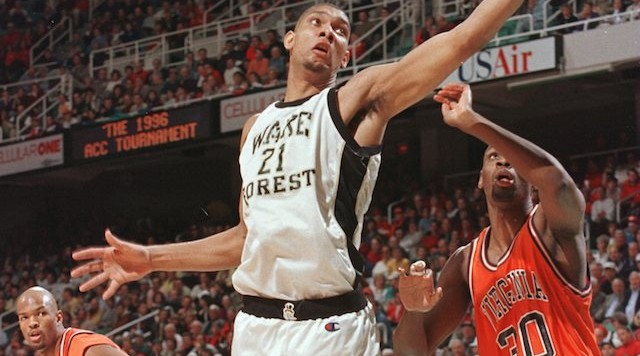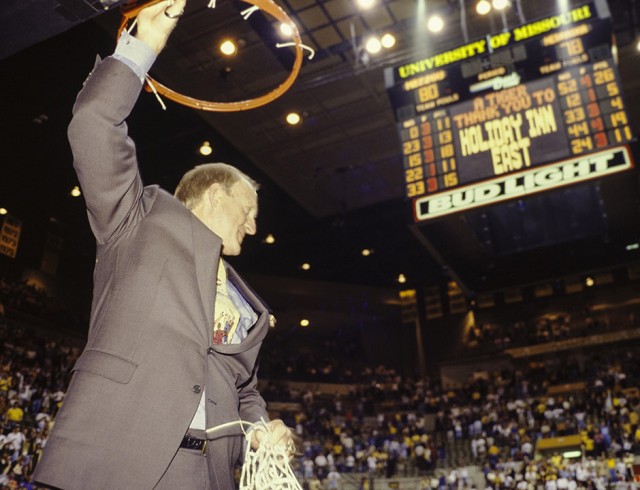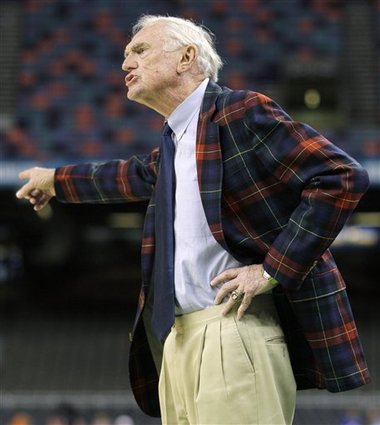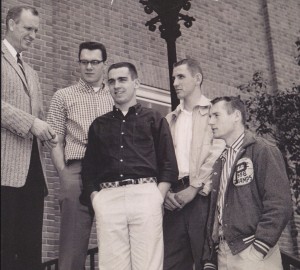The ACC Tournament began Tuesday afternoon, accelerating the parade of conference tournaments. The flurry of conference tournament basketball will reach its crescendo on Thursday and Friday, arguably the two craziest weekdays of the entire season.
The conference tournaments possess an uncertain identity in college basketball. In the ACC, the conference tournament is sacred — largely because the sport is cherished in that part of the country, but also because the ACC Tournament is the signature college basketball tournament, the one with the most resonance and stature. The conference tournament is a relatively new thing in the Big Ten, and in the Pac-12, it’s just not a big deal throughout the entirety of the conference. The Big East used to be a larger-than-life conference tournament. Now, it’s just one out of many tournaments thrown together this week. The SEC Tournament started before all the other ones, but it then ceased to exist for 26 seasons, from 1953 through 1978. Getting a sense of what each conference tournament means is elusive. It depends on the school and the region in the country.
Nevertheless, this is a significant part of college basketball’s identity. These are championship events, which gets overlooked in the stampede to discover who’s in and who’s out on Selection Sunday. Unlike the bowl games which dominate three weeks of the calendar, the conference tournaments are typically four- or five-day events. Only in a rare case such as the America East or the Patriot League (with each game at a campus site, several days after the previous round) does a conference tournament take up more than a full week.
Without further ado, then, here are 10 facts from conference tournament history which you might not have known. We hope you’ll find them eye-popping to some degree:
10 – COLONIALISM IS VICIOUS
What history has known in global terms as colonialism — settling new territories, taking over lands — has often brutalized local populations. In college basketball, the churn and turnover in the Colonial Athletic Association has been constant. Schools have been tossed about time and again, making the recent round of college football realignment seem like child’s play.
The Colonial has been redrawn and changed so many times as a basketball league that through 2012 — encompassing the first 33 CAA tournaments — only three times has the CAA Tournament final paired two schools which are still in the league.
That’s right — since the first CAA Tournament in 1980, and before VCU left for the Atlantic 10 in 2013, only three CAA finals were “originals.” The 1983, 2003, and 2006 meetings were the only instances in which current CAA schools clashed for the tournament championship. Interestingly enough, the last of those meetings (2006) was re-created Monday night, when UNC-Wilmington defeated Hofstra in the final.
9 – ATLANTIC 10 TURNOVER
The dynamics in play with the Colonial were just as evident in the Atlantic 10, a conference which shares the CAA’s geographic footprint in the mid-Atlantic region but extends more into other regions of the country.
The first Atlantic 10 Tournament was staged in 1977. In the first nine A-10 tournaments, each championship game produced only two members that are still in the conference today: Duquesne and Saint Bonaventure. Villanova, West Virginia, Penn State, Rutgers, Temple — all these schools which used to exist in the A-10 — found homes in power conferences. WVU, PSU and RU all landed in Power 5 (i.e., BCS) conferences.
Here’s a stat akin to the Colonial item mentioned above: In the first 28 A-10 Tournament finals, only one (!) pitted two teams still in the conference today. The 1997 final matched Saint Joseph’s and Rhode Island. It wasn’t until 2005 that another pair of current members faced off in a final (Saint Joe’s and George Washington).
7 and 8 – COLORADO, NEBRASKA, TEXAS, AND INDIANA: UNITED IN WEIRD WAYS
The basketball pedigree of Indiana University needs no explanation.
The basketball history of the University of Texas — given the size of the state and the resources of the school — should be substantial, but isn’t.
The basketball credentials of the University of Colorado and the University of Nebraska aren’t very impressive… and no one would give that statement a second thought.
Yet — this is said with full knowledge of the fact that Indiana didn’t play in a conference tournament for many decades — it still rates as a shock: Colorado and Nebraska have each won more conference tournaments than Indiana. The Buffs and Huskers have won one, the Hoosiers none.
Another surprise: Colorado and Nebraska have as many conference tournament titles, combined, as Texas has, in a roughly equal period of time. The Southwest Conference began its tournament in 1976, the old Big Eight (with CU and NU) in 1977. Texas won two SWC titles but has not won a single Big 12 Tournament championship, going 0-6 in title games. Colorado won a Pac-12 title, and Nebraska snagged a Big Eight title in 1994.
6 – MIZZOU BISOU BISOU: THE TIGERS REVELED IN THE BIG EIGHT TOURNAMENT
The rock-bottom condition of Missouri basketball, coupled with the absence of a single Final Four from the program’s history, might make you think the Tigers probably didn’t do much in the Big Eight or Big 12 Tournaments.
That idea couldn’t be further from the truth.
Missouri has won two Big 12 Tournament titles, and the Tigers won six Big Eight Tournament titles before the league changed to the Big 12 in 1997. Coach Norm Stewart won all six Big Eight Tournaments. Missouri’s six crowns exceeded the four tournaments won by Kansas and Oklahoma.
5 – TEXAS TECH: THE VACUUM CLEANER
The vacuum cleaner? What the heck does that mean?
Here’s the explanation:
Houston’s Phi Slama Jama teams ruled the Southwest Conference in the early 1980s, but then they left. Texas Tech won the SWC Tournament in 1985 and 1986 under coach (and later athletic director) Gerald Myers. The Red Raiders filled a vacuum in the conference.
Arkansas dominated the league in the late 1980s and early 1990s under Nolan Richardson, but then the Hogs migrated to the SEC. Texas Tech won two more SWC tournaments before the league folded following the 1996 season.
Texas Tech has five conference tournament titles, a number which is improbably large in relationship to the rest of the Red Raiders’ relatively meager basketball history.
As a point of comparison with Texas Tech, consider Virginia. The Cavaliers’ feats in the 1980s under Ralph Sampson, and then their journey to the Elite Eight in 1995, would make you think they’ve won their share of ACC Tournaments over the years. Instead, they’ve won only one ACC tourney since 1976, and only two overall, over more than 60 years.
Texas Tech 5, Virginia 2. Not what you would have expected, right (even when adjusting for strength of conference)?
4 – THE DESERT: LONG TOURNAMENT CHAMPIONSHIP DROUGHTS
The SEC Tournament ran from 1933 through 1952, but as mentioned above, it stopped from 1953 through 1978. Because of this interruption, long periods between conference tournament titles emerged for a few schools.
Georgia Tech, a member of the SEC when it won the conference’s tournament in 1938, didn’t win another conferenc tournament until 1985, nearly a half-century later.
Vanderbilt, though, suffered the longer drought: The Commodores won just before the 1953 stoppage, taking the 1951 SEC Tournament. They didn’t win again until 2012, creating a 61-year gap.
At least VU ended its drought, however. A few SEC schools have gone more than a third of a century without a title: LSU last won the SEC Tournament in 1980, and Tennessee last won it in 1979. Tennessee owns a painful distinction of having two separate conference tournament title droughts of at least 36 years: 1943-1979, and then 1979 to the present day.
South Carolina didn’t join the SEC until 1992, but the Gamecocks’ last tournament title was the 1971 ACC crown.
The ACC Tournament is the oldest continuous conference tournament, having suffered no interruptions akin to what the SEC experienced. The event began in 1954, so that means 62 conference tournaments have been held.
We give you the Clemson Tigers:
There have been 62 ACC Tournaments. Clemson: 18-62 w/ two title-game losses.
— Aaron Brenner (@Aaron_Brenner) March 8, 2016
3 – WIMP ISN’T WIMPY
The Kentucky Wildcats have won 28 SEC Tournament championships. That’s 22 more than any other SEC school. You would think, then, that Kentucky coaches comprise the top three or four leaders in SEC Tournament titles.
Well, they DO… but there’s a non-Kentucky coach in the mix.
This guy:
He’s one of the quietly underappreciated coaches in college basketball history. Wimp Sanderson, the man with the loud plaid jackets, won five SEC Tournament championships at Alabama. Those five titles are more than any other non-Kentucky SEC school. Billy Donovan of Florida has won four.
Alabama owns six SEC Tournament titles, alone in second place in the league. That’s because of Wimp, who made the Sweet 16 six times in Tuscaloosa.
Kentucky does have two coaches other than Adolph Rupp (13 SEC Tournament titles) who have matched Sanderson’s five crowns. Rick Pitino and Tubby Smith both hit five, but they didn’t surpass Wimp. He can say that only Rupp has more SEC Tournament championships than he does. It’s quite a remarkable thing to say within the larger sweep and scope of SEC basketball history… and college basketball history at large.
2 – GEORGETOWN, SYRACUSE, AND BIG EAST HEGEMONY
The Big East Tournament is no longer what we once knew it to be, an event which could (and did) stand on par with the ACC Tournament. However, it’s always worth appreciating the history of this tournament, in order to accordingly appreciate the programs that have come and (mostly) gone.
Start with this fact: In the first 15 Big East Tournaments — from 1980 through 1994 — Georgetown or Syracuse played in the championship game every year but once (1983, St. John’s versus Boston College).
Continue with this fact: When Villanova and Connecticut met in the 1995 final to break up the Georgetown-Syracuse axis, Connecticut began its Big East reign by making eight finals in a span of 10 years, through 2004. Jim Calhoun used that period to win five of his record seven Big East titles. The Thompson family — Big John and JT3 — have won seven combined (6 for Papa, 1 for the son), enabling GU and UConn to tie for most Big East Tournament championships, with seven each. Syracuse won five.
Finish with this fact: Rick Pitino and Louisville were in the Big East for a very short period of time — less than a full decade following the exit from Conference USA — but won more Big East Tournament titles (3) than every school other than Georgetown, UConn, and Syracuse.
Georgetown and Syracuse built the Big East Tournament (with help from St. John’s).
Connecticut continued it.
Louisville finished it.
*
1 – BILLY PACKER AND TIM DUNCAN:
EQUALLY ACCOMPLISHED ACC TOURNAMENT HEROES AT WAKE FOREST
See the guy in the dark shirt? He’s the guy who announced the Final Four every year from 1975 through 2008. He’s the guy who irritated many college basketball fans (disclosure: not me) with his highly opinionated and unapologetic manner of speech. He was, in many ways, a curmudgeon, but he forged one of the great sports broadcasting careers of all time.
This man was nowhere near Tim Duncan’s equal as a college basketball player, right?
Well… umm… he was.
Wake Forest has won four ACC Tournament championships.
Tim Duncan won two as a player. So did Billy Packer.
The Demon Deacons won these four titles in separate back-to-back pairs.
Tim Duncan did so in 1995 and 1996. Billy Packer did the deed in 1961 and 1962.
ACC historians have known this for some time. For North Carolinians and people who cherish the ACC, this is common knowledge.
For anyone outside the ACC, your mind just might have been blown to pieces.




